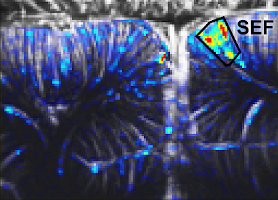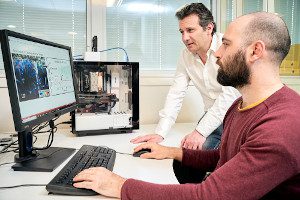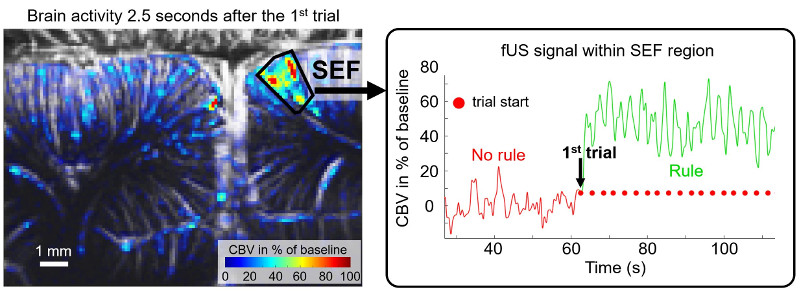
New publication in Nature Communications

Credits: G. Murat/ESPCI Paris
Researchers of the laboratory Physics for Medicine Paris at the Ecole Supérieure de Physique et Chimie Industrielles (ESPCI Paris, PSL University, Inserm, CNRS) in collaboration with teams from the Brain and Spinal Cord Institute (APHP, Inserm, CNRS, Sorbonne Université) and the Vision Institute (Sorbonne Université, Inserm, CNRS) in Paris have achieved a major advance by studying the brain during complex cognitive tasks. Using a new imaging method, coined “fUS imaging” (functional ultrasound imaging) and providing a high spatial and temporal resolution, the research team has imaged the activation in the brain of a primate performing visual tasks. Even better, the high-sensitivity measurements has enabled to track the propagation of neuronal information across the brain. The work has just been published in Nature Communications.
Over the past twenty years, neuroimaging methods have revolutionized our understanding of the brain. They enable to monitor the cerebral activity and therefore try to elucidate the mechanisms involved in the brain. Traditional methods (functional MRI or electrophysiology) however remain cumbersome, and require averages over repeated acquisitions.
Researchers of Physics for Medicine Paris have developed a disruptive technology with a very high sensitivity and high spatial and temporal resolution. So far, the technique had been applied to study the brain at resting state or in response to simple somato-sensory stimuli. Here, fUS imaging has been used to monitor complex cognitive tasks. The researchers have measured with a 100-micron spatial resolution and over 10-ms time scales the local variations of blood flow in a primate brain region, called supplementary eye field (SEF). This brain region is associated with decision making in the context of predefined rules.

In practice, the primates are performing a series of oculomotor tass (track a point target projected on a screen, gaze oppositely to the point target…) while their cerebral activity is monitored using a non invasive fUS imaging device. The scientists have been able to retrieve the task performed by each of the animal, as well as predicting their success rate. Another remarkable result: the high imaging rate has enabled to track the propagation of the neuronal information across superficial and deep areas of the cerebral cortex.
The collection of a rich content of valuable data through a robust and portative technology makes functional ultrasound imaging an extremely powerful tool to investigate complex cognitive processes.
Read the full publication here.
Alexandre Dizeux, Marc Gesnik, Harry Ahnine, Kevin Blaize, Fabrice Arcizet, Serge Picaud, José-Alain Sahel, Thomas Deffieux, Pierre Pouget, Mickael Tanter, Functional ultrasound imaging of the brain reveals propagation of task-related brain activity in behaving primates, Nature Communications 10, Article number: 1400 (2019), doi:10.1038/s41467-019-09349-w
This work was supported by the European Research Council (ERC Advanced Grant FUSIMAGINE and ERC Synergy Grant HELMHOLTZ).





